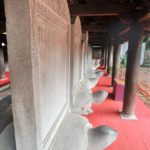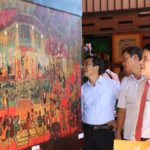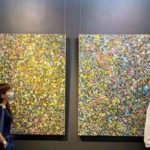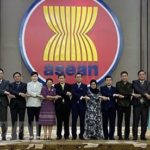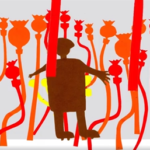The Van Mieu (Temple of Literature) watercolors are currently on display at the EM Exhibition, aimed at raising funds for underprivileged children.
This project is led by young artist Phan Anh Thu, who is donating 100% of the proceeds from the sale of the paintings and her art book titled Thu thenh thang (Thu Timeless Travel) to fund the construction of a school for children in impoverished areas of the Central Highlands. The goal is to raise VND600 million (US$25,000).
The Temple of Literature is an exceptional national monument that houses a unique architectural masterpiece known as the Khue Van Pavilion. This pavilion, built during the Nguyen Dynasty, is considered a symbolic representation of Vietnamese literature and education.
| The exhibition consists of 50 paintings. Photo: The Hanoi Times |
According to painter Thu, the Khue Van Pavilion, despite its modest size, emanates simplicity and elegance, embodying the essence of Thien Quang Tinh (Heavenly Clarity Well). Surrounded by ancient trees and overlooking a square lotus pond, the pavilion represents wisdom, scholarship, and the realm of literature with its Khue Star (Legs Mansion), one of the Chinese constellations.
Thus, the Khue Van Pavilion, capturing the beauty of the Khue Star, symbolizes the pinnacle of intellectual accomplishments and reinforces the timeless truth inscribed on the steles of Van Mieu: “Virtuous talents are the vital elements of a nation.”
| Painter Phan Anh Thu wants to use art to raise funds for poor children. Photo: The Hanoi Times |
The exquisite aesthetics of Khue Van Pavilion are enhanced by its round windows, which vividly depict the radiant image of the Khue Star in the sky, symbolizing the brilliance of virtuous talents and their contribution to the realm of intellect and knowledge.
In addition to the paintings inspired by Van Mieu, the exhibition showcases around 50 works carefully selected from more than 500 paintings created by artist Phan Anh Thu. Each piece tells a unique story, depicting diverse scenes ranging from urban to rural areas across the country, including the Northwest, Hanoi, Hue, Hoi An, and Ho Chi Minh City.
| Phan Anh Thu paints at the Temple of Literature, Hanoi. |
While discussing her journey of creating hundreds of paintings nationwide, especially in remote areas, Phan Anh Thu shared her firsthand experiences of witnessing the challenging lives of children in the highlands.
In addition to manipulating colors, artist Phan Anh Thu provides insights into each work through her art book.
Art critic Ly Doi commented that with this art book, the artist transcends mere illustration and has the opportunity to establish her name through brushstrokes, creativity, and an unprecedented story.
The exhibition will be open until August 6 at AMANAKI Hotel, located at 10 Nguyen Dang Giai, Thu Duc City, Ho Chi Minh City.
| Temple of Literature. |
| Khue Van Cac, a symbol of Hanoi. |
| Ngo Mon Gate in the ancient capital of Hue. |
Stone Stele Records
In March 2010, a system of 82 stone stele records of doctoral laureates in Van Mieu – Quoc Tu Giam (Temple of Literature – the First National University of Vietnam) in Hanoi was recognized as a World Documentary Heritage by UNESCO. These stele records show the most complete and clearest history of imperial examinations of the Vietnamese feudal dynasties.







